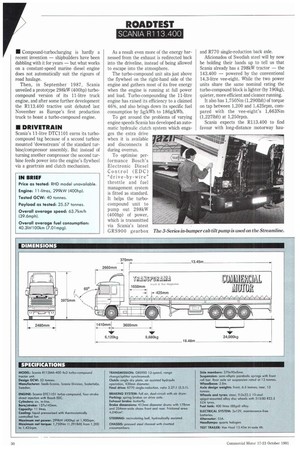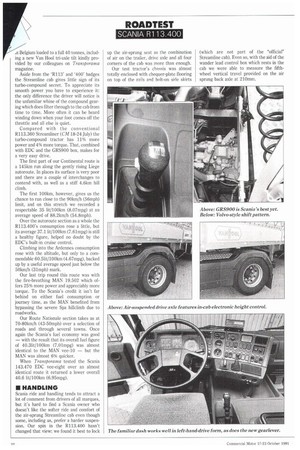ROADTEST
Page 32

Page 33

Page 34

Page 35

If you've noticed an error in this article please click here to report it so we can fix it.
SCANIA R113.400
I/ Compound-turbocharging is hardly a recent invention — shipbuilders have been dabbling with it for years — but what works on a constant-speed marine diesel engine does not automatically suit the rigours of road haulage.
Then, in September 1987, Scania unveiled a prototype 298kW (400hp) turbocompound version of its 11-litre truck engine, and after some further development the R113.400 tractive unit debuted last November as Europe's first production truck to boast a turbo-compound engine.
Scania's 11-litre DTC1101 earns its turbocompound tag because of a second turbine mounted 'downstream' of the standard turbine/compressor assembly. But instead of turning another compressor the second turbine feeds power into the engine's flywheel via a geartrain and clutch mechanism. As a result even more of the energy harnessed from the exhaust is redirected back into the driveline, instead of being allowed to escape into the atmosphere.
The turbo-compound unit sits just above the flywheel on the right-hand side of the engine and gathers most of its free energy when the engine is running at full power and load. Turbo-compounding the 11-litre engine has raised its efficiency to a claimed 46%, and also brings down its specific fuel consumption by 5g/kWh to 186g/kWh.
To optimise performance Bosch's Electronic Diesel Control (EDC) "drive-by-wire" throttle and fuel management system is fitted as standard. It helps the turbocompound unit to pump out 298kW (400hp) of power, which is transmitted via Scania's latest GRS900 gearbox and R770 single-reduction back axle.
Aficionados of Swedish steel will by now be holding their hands up to tell us that Scania already has a 298kW tractor — the 143.400 — powered by the conventional 14.3-litre vee-eight. While the two power units share the same nominal rating the turbo-compound block is lighter (by 190kg), quieter, more efficient and cleaner running.
It also has 1,750Nm (1,2901b1t) of torque on tap between 1,200 and 1,425rpm, compared with the vee-eight's 1,663Nm (1,2271bft) at 1,250rpm.
Scania expects the R113.400 to find favour with long-distance motorway hau Scania 's 11-litre engine is the first automotive application of turbocompounding. As can be seen, an extra turbine transmits power from the exhaust gases via a gear train direct to the flywheel.
hers happy to accept a more highly stressed engine in exchange for less weight, while the R143.400 will retain its popularity among more traditional operators who want a big, lazy vee.
Unfortunately for British operators the decision has already been taken for them. If you want a 298kW Scania you'll get the R143.400 whether you like it or not as the R113.400 will not be available in Blighty for some time. As with the first generation of EDC equipped tractors, Scania is evaluating the performance of the RI13.400 in a limited marketplace before making it freely available throughout Europe. Scania (Great Britain) does not expect right-hookers to be available before mid-1993.
Belgium loaded to a full 40 tonnes, including a new Van Hool tri-axle tilt kindly provided by our colleagues on Transporama magazine.
Aside from the R113 and '400' badges the Streamline cab gives little sign of its turbo-compound secret. To appreciate its smooth power you have to experience it: the only difference the driver will notice is the unfamiliar whine of the compound gearing which does filter through to the cab from time to time. More often it can be heard winding down when your foot comes off the throttle and all else is quiet.
Compared with the conventional R113.360 Streamliner (CM 18-24 July) the turbo-compound tractor has 11% more power and 4% more torque. That, combined with EDC and the GRS900 box, makes for a very easy drive.
The first part of our Continental route is a 145km run along the gently rising Liege autoroute. In places its surface is very poor and there are a couple of interchanges to contend with, as well as a stiff 4.6km hill The first 100km, however, gives us the chance to run close to the 90km/h (56mph) limit, and on this stretch we recorded a respectable 35 lit/100km (8.07mpg) at an average speed of 88.2km/h (54.8mph).
Over the autoroute section as a whole the R113.400's consumption rose a little, but its average 37.1 lit/100km (7.61mpg) is still a healthy figure, helped no doubt by the EDC's built-in cruise control.
Climbing into the Ardennes consumption rose with the altitude, but only to a commendable 60.5lit/100krn (4.67mpg), backed up by a useful average speed just below the 50km/h (31mph) mark.
Our last trip round this route was with the fire-breathing MAN 19.502 which offers 25% more power and appreciably more torque. To the Scania's credit it isn't far behind on either fuel consumption or journey time, as the MAN benefited from bypassing the severe Spa hillclimb due to roadworks.
Our Route Nationale section takes us at 70-80km/h (43-50mph) over a selection of roads and through several towns. Once again the Scania's fuel economy was good — with the result that its overall fuel figure of 40.3lit/100km (7.01mpg) was almost identical to the MAN vee-10 — but the MAN was almost 6% quicker.
When Transporama tested the Scania 143.470 EDC vee-eight over an almost identical route it returned a lower overall 40.6 lit/100km (6.95mpg).
Scania ride and handling tends to attract a lot of comment from drivers of all marques, but it's hard to find a Scania owner who doesn't like the softer ride and comfort of the air-sprung Streamline cab even though some, including us, prefer a harder suspension. Our spin in the R113.400 hasn't changed that view: we found it best to lock up the air-sprung seat as the combination of air on the trailer, drive axle and all four corners of the cab was more than enough.
Our test tractor's chassis was almost totally enclosed with chequer-plate flooring on top of the rails and bolt-on side skirts (which are not part of the "official" Streamline cab). Even so, with the aid of the wander lead control box which rests in the cab we were able to measure the fifthwheel vertical travel provided on the air sprung back axle at 210mm. What is there to say that hasn't already been said about the Series 3 Scania cab interior? Quite simply, it's excellent: well made and rattle free. We particularly like the visibility. Scania always has the biggest and best mirrors in the business; one-piece electric windows and central locking keep the Streamline cab firmly in the "premium" category.
This roadtest is also the first full appraisal by any UK magazine of Scania's all-new GRS900 12-speed gearbox which follows the Volvo pattern by using the type of small h-shift pattern traditionally found on the heavy truck transmissions fitted by its archrival.
In our opinion the synchromesh GRS900 is the best Scania box to date. It has answered all the old moans by being light and quick and, most important of all, you can't beat it through the range change and end up with a false neutral. A sliding collar operates the range change while a new rocker switch on the side of the lever takes care of the splits.
British drivers may still come to rue the day that someone in Sweden decided to position the lst/4th gate rearward of neutral. It was the difficulty in getting this gear in the pre-1989 10-speed boxes which effectively equipped most right-hand-drive 142s with an eight-speeder!
However, the new box is undeniably slicker and does not place such a strain on the arm in any gear.
Technically our left-hand-drive R113.400 is almost indistinguishable from the R113.360 we tested in the summer, with the obvious exception of EDC and its shorter 3.6m wheelbase. For that reason we've been able to make use of the R113.360's parts prices, workshop times and contract maintenance figures.
The compact power of the new turbo-compound engine, together with its pleasing driveability and all-round suitability for highspeed long-haul work makes the R113.400 a strong contender in the TIR tractor stakes.
Based on our experience of both trucks, we would rate the EDC-equipped R113.400 over the non-EDC R143-400 because of its savings on weight, noise and most probably cost.
It's a pity that UK hauliers will have to wait to get their hands on the R113.400, although considering the current recession it's not surprising that Scania is in no hurry to bring out a right-hooker. But if the economy does start picking up by the middle of next year and operators actually start buying new trucks again, Scania would do well to remember that potential R113.400 buyers may choose not to wait until 1993 and will spend their money on something else — and there's no guarantee that it will be a Scania with a vee-eight.
by Danny Coughlan




















































































